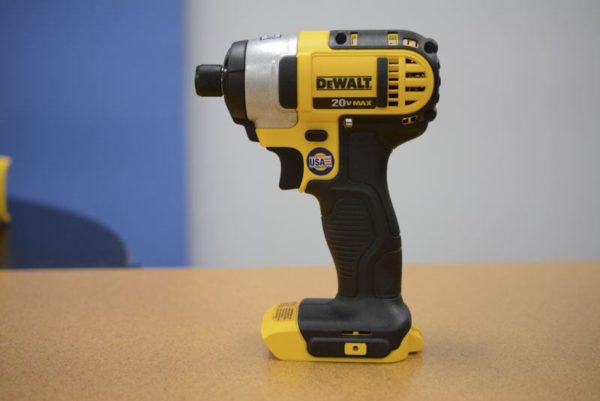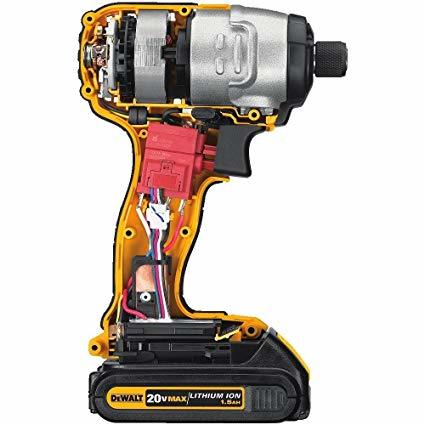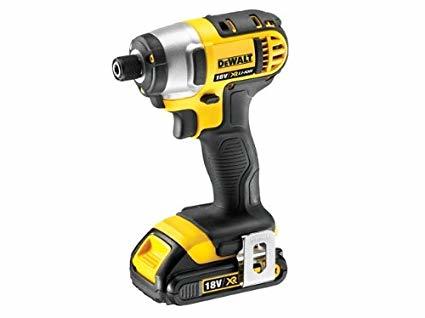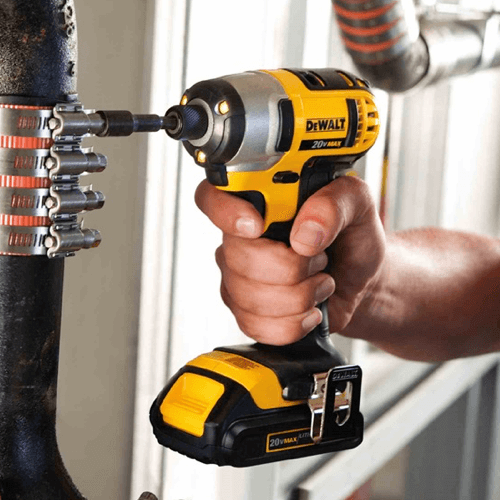Dewalt DCF885 Impact Driver – Review & Buyer’s Guide

Apart from being a toolbox essential, an impact driver is one of those tools that can make quick work of long, tedious tasks. Are all impact drivers the same? Of course not.
One of the things that can influence the speed or power of an impact driver, for instance, is the type of motor that powers it. Everything from the torque to the battery and dimensions of an impact driver contributes to its efficiency and its ability to handle tasks of varying difficulty.
What are the most important considerations to make when buying an impact driver? Here’s what you need to look out for.
- Compact (5.55 front to back), lightweight (2.8 lbs) design fits into tight areas
- 3 LEDs with 20-second delay after trigger release, provide visibility without shadows
- One-handed loading 1/4 hex chuck accepts 1 bit tips
Last update on 2025-10-07 / Affiliate links / Images from Amazon Product Advertising API
10 Things to Consider When Buying an Impact Driver
1. Brushless vs. Brushed Motor
Brushed and brushless motors are the two types of motors you’d find in an impact driver. Brushed motors are cheaper, but that’s only because they don’t work very efficiently. They convert a lot of their power into heat, making them less efficient and also prone to overheating.
Brushless motors are a newer and better option. Because they run so efficiently, brushless motors don’t generate a lot of extra heat. They run very coolly and are better suited to handling large or heavy duty tasks.
2. LED Lights
Unless you don’t mind shooting in the dark when working in low-light environments, picking an impact driver with decent LED lights should be the way to go.
Impact drivers usually have a ring of LED’s that illuminate the work area to reduce accidents and increase efficiency. Though most might call this a personal preference, I think seeing your work clearly is important if you want to do it right.
3. Speed Range
Much like cordless drills, impact drivers can only offer so much in terms of rotation speed. Most of them come with a rotation element, so it is necessary to know how fast it can or can’t go. The speed range is basically the range of speeds that an impact driver is capable of. Obviously, you want one that can work as fast or as slowly as you need it to.
4. Torque
Impact drivers are powerful enough to drive projectiles like nails and screws into solid objects. This is made possible by the amount of torque they have. It doesn’t matter how big or small an impact driver is — its torque is the ultimate determiner of its work capacity.
Torque is a measure of pulling or pushing force. An impact driver’s torque rating tells you how big a screw it can punch into the wall despite its size.
5. Impacts Per Minute
It helps if you think of the impact element in an impact driver as a tiny hammer that delivers a powerful impact on drill bits to drive them into solid objects. These hammers can deliver several of these impacts per minute. Depending on the nature of your work, you’ll want your impact driver to be capable of a certain amount of impacts every minute. Different drivers have different impact per minute ratings, with those on the higher end being slightly more expensive than those with lower impacts per minute.

6. Corded vs. Cordless
Cordless impact drivers are naturally more maneuverable. They’re easier to use in tight spaces and awkward angles as they’re not constantly tethered to a cable. Furthermore, their lack of a power cord is one less tripping hazard to worry about in the workshop.
It is arguable that you might be trading power for convenience if you choose a cordless driver over a corded one. This isn’t always the case. Some cordless impact drivers can be quite powerful even though they run on battery. The only downside is that there are unavoidable periods of downtime when the battery runs out of juice and has to be recharged.
7. Chuck Preference
In an impact driver, you either have a 1/4-inch chuck or a 3/8-inch chuck. Because the chuck is where the drill bit is inserted, it helps to know the type of bits you intend to use with your impact driver before purchase.
All impact drivers, whether cordless or corded, will have one of the two chuck configurations, so make sure to check the one you decide to buy to make sure it’s the right one.
8. Voltage
The voltage requirement of any power tool is often one of the biggest considerations to make. However, in the case of impact drivers, the voltage doesn’t affect much more than the driver’s speed.
Remember that if you spring for a higher voltage tool, you’re effectively giving up some maneuverability since such power tools tend to be heavy. What this basically means is that you shouldn’t be too hung up on the voltage rating of an impact driver. It’s just not that important.

9. Batteries
It should go without saying that Lithium-ion batteries are the best technology we have today, so don’t settle for less.
Battery power matters a huge deal to the regular hobbyist or professional. Ideally, you want a battery that will let you work with minimal downtime. It should hold a charge well enough but also charge as fast as you need it to do.
Insufficient battery power can limit your productivity and force your impact driver to spend more time on the charging dock than on the job. Make this decision very wisely.
10. Weight and Dimensions
Weight matters more than you think. Think about it this way. A heavier tool takes a lot more effort to use. You get tired quicker and therefore you can’t work for as long as you’d like to.
The same applies to the dimensions of the impact driver you settle for. Remember, this is a power tool that’s used by hand, so you want it to be as ergonomic and as easy to use as possible, especially if you intend to use it a lot.
Dewalt DCF885 Pros & Cons
Pros
- It’s a powerful tool
- Small build, easy to maneuver
- 3-LED ring of lights
- Good price
- Excellent accessories
Cons
- Large batteries
- No on-board bit holder
6 Things you’ll like about the Dewalt DCF885 Impact Driver
If you’ve been a fan of the DC825 impact driver, which has been a favorite among professionals and weekend warriors for the longest time, then Dewalt’s DCF885 might be right up your alley. It’s small, powerful, and very nifty for a tool that’s so far from the $100 price point.
Will you find value with the DCF885? Is it worth upgrading to? Let’s look at 5 highlights of this impact driver.
1. The Power
The DC825 offered 1,330 in-lbs of torque, which most users found plenty for their construction tasks. The DCF885 brings about 70 in-lbs more to the table, a more than decent upgrade.
It is a brushed motor that powers it, however, so it’s certainly not the most powerful or the most efficient impact driver you can get.
Nevertheless, if you can find ways to avoid overheating (such as using it in intermittent spells), it is well capable of powering through most tasks without complications.
2. The Build
Straight off the bat, you’ll notice that the DCF885 looks shorter than most other impact drivers. That’s because it is. At a length of 5.5 inches without bits, it is easily one of the shortest, stubbiest impact driver you’ll be able to find today.
Is this a useful attribute? In some ways, yes. It’s slightly more maneuverable due to its size. You’ll find it easier to use in tight corners, and since it measures only 2.1 pounds, you won’t need to take a lot of breaks to rest your hand.
3. The Improved Chuck
To take full advantage of the DCF885’s size, Dewalt did something special. They gave it a chuck that’s compatible with 1-inch bits, which is quite a feat on an impact driver with a head this short.
It might not seem like much, but any handyman would appreciate the convenience of having something extra short that can hold 1-inch bits this well.
As if that’s not enough, Dewalt also produced a variant of the DCF885 that’s equipped with a quick-release chuck that makes replacing the bit with one hand possible. It doesn’t get much more convenient than this.
4. The 3-LED Ring
We talked about how important having a light source is when working with an impact driver. The DCF885 offers plenty of illumination with a ring of three LED lights. They’re bright enough, but more importantly, the light trigger has a 20-second delay before it goes off, so you don’t have to keep a finger on it when working in the dark.
An impact driver is infinitely more useful if it has a decent source of illumination. That’s what makes the DCF885 such a versatile power tool.
5. The Price
After going through the features and specifications of the DCF885, you’d be tempted to give it a much higher price tag than it comes with.
Great quality and excellent functionality might lure you into giving the DCF885 a second look, but it’s the shockingly low price that will convince you to take the leap. At anywhere under $100, it’s hard not to feel that the impact driver is massively underpriced. That’s how much value you get from the DCF885.
6. The Accessories
The DCF885 is by no means a complete toolset, but the accessories it ships with are a nice bonus.
You get a tool belt as well as a carry case with every unit you buy. Considering the price of the bare tool, this is quite a good value for money.
What You Might not Like about the Dewalt DCF885
It is worth mentioning that while the DCF885 is a heck of a power tool, it is not without its shortcomings. Here are two areas where the impact driver falls short of expectations.
1. Using Larger Batteries
If you’re planning to increase its productivity by using a larger battery, then the DCF885 might disappoint you. That’s because it is very, very light, so even a 3.0 A-h will make it imbalanced enough to hinder your ability to work with precision.
This is certainly not a good attribute, especially since it’s always nice to be able to upgrade the battery size on your power tools.
2. The Lack of an On-board Bit Holder
This is one of those things you don’t miss until you’re halfway through a job and realize that you’re taking a lot of time to look for bits. An onboard bit holder is a common feature on many impact drivers so it’s disappointing to see that it lacks on the DCF885.
Is this a make-or-break issue? For some handymen, probably. But if you can deal with the mild inconvenience of having to store your bits on your person or somewhere close to the workstation, then this isn’t something that will bother you too much.
One Tip to Solve Chuck Complications
Cheaper bits have a nasty tendency to get stuck in the impact driver. A 1-inch bit, for instance, only has 1/4 of an inch held securely by the chuck. Even with Dewalt’s excellent craftsmanship, a bit will get stuck every so often.
To deal with this, try a quick reverse pulse when the bit is in a screw, or give the impact driver a light tap against a hard surface. Usually, this will do, but if it doesn’t work, then you’ll need to grab the bit with a pair of pliers and pull it out.
Bottom Line
The Dewalt DCF885 Impact Driver is definitely not the most powerful nor the most excellently built impact driver in the market. It uses a brushed motor too, so it’s also not all that efficient.
However, should you decide that it’s good enough for you, you’ll find that it can be quite easy to love. It is one of the shortest 18V drivers available today, and though this isn’t exactly a key selling point, its improved chuck certainly is. Very few impact drivers with 1/4-inch chucks can hold a 1-inch bit as well as the DCF885, and you’ve got to give credit where it’s due.
A torque of 1,400 lb-in isn’t something to sneeze at, and with an impact rating of 3,200 IPM (impacts per minute), the DCF885 won’t let you down when it’s time to put in some work.
Overall, it is an affordable and very well-balanced power tool with a couple of added bonuses that make its price tag seem to be spot on for value.
[su_asin asin=”B01LBT3AZU”]Last Updated on August 15, 2020 by Tom Bradly


